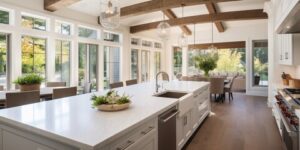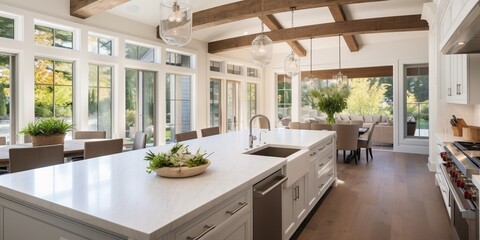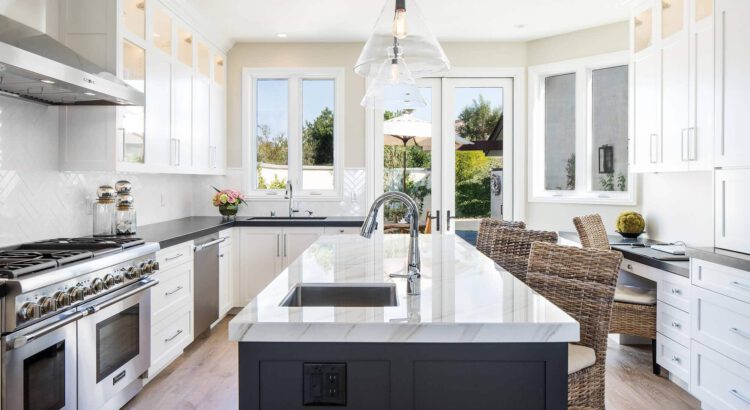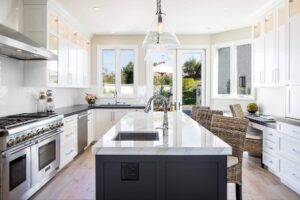The kitchen remodel goals you define for your project will influence many decisions, including the choice of cabinets and countertops. There are many options for both, from natural stone to manufactured products.
Be sure to factor in plenty of storage space, especially in lower cabinetry. Also, consider unique design elements like a knife drawer.
Cabinets are one of the largest components in a kitchen and typically account for up to 40% of your remodel costs. If you’re happy with the layout of your cabinets but would like to freshen up their appearance, consider repainting. This can be a fairly labor-intensive DIY project but will cost a fraction of replacing them. A local kitchen design professional can help you select a paint color that will coordinate with your existing colors and blend well with adjacent cabinetry.
If you’re adding new cabinets, or have space to add a few uppers, consider upgrading the back panels. Most cabinet manufacturers offer a selection of different options, including plywood that matches the existing cabinets for a seamless look and stronger construction that’s less likely to sag over time.
Other less-expensive options use thin panels, metal hanger rails and brackets, or picture-frame construction. Choose the plywood option to add durability and ensure that your cabinets are properly supported, as these less-expensive methods can lead to falling cabinetry.
For a more modern look, choose open shelving as an alternative to traditional cabinets. This is a great way to show off favorite dinnerware, glassware, or decorative teapots. It’s also a good place to stash cookbooks and other reading materials in easy reach.
Under-cabinet lighting is another easy upgrade that will make it easier to see and reach items in upper cabinets. It can also create a sultry, contemporary feel or a cozy distant effect depending on the warmth of the light and the color used. Consider adding power strips and USB plugs for convenience.
Countertops
Countertops have a big impact on the overall look of your kitchen. They need to match your cabinets for a cohesive design, but they also offer a great opportunity to make a statement and showcase your personal style. Whether you go for the natural look of stone or a modern quartz slab, there’s a countertop to fit every style.
The most popular choice is granite, which is heat- and scratch-resistant and can stand up to heavy use for years to come. Another option is marble, which offers a classic beauty with a timeless look. If you prefer something less permanent, laminate countertops are a budget-friendly choice that comes in many colors and styles. But they’re not as durable as other materials and won’t add resale value to your home.
If you’re looking for a more unique countertop, consider concrete. It’s a strong, customizable material that can be stained in any color or given a textured finish. It’s an eco-friendly alternative to traditional stone, and it’s easy to install DIY. Another option is wood, which works well with rustic or farmhouse-style designs.
Backsplashes also make a big difference in your kitchen. They’re a functional element that helps prevent spills and grease from damaging the wall behind your countertop. These fixtures can be as simple or as complex as you want, but they can offer an excellent opportunity to bring a creative touch to your kitchen remodeling project.
For a more long-term update, you can paint your counters or refresh them with contact paper. Both of these options are inexpensive and provide a quick way to change the look of your kitchen. They’re also ideal for rental properties or if you need to remodel on a tight budget.
Appliances
Whether you’re upgrading to new appliances to improve function or add style, the types and brands you choose are key to your kitchen remodel. Choose major appliances that match both your cooking needs and the look you’re after – a wide range of sizes and designs are available to suit any space.
A well-thought out appliance plan is crucial to your kitchen’s design and flow, as they are typically one of the biggest line items in any renovation budget. For this reason, many homeowners take the time to consider and test drive multiple options before making a purchase. Some of the most popular choices include a gas, electric or induction cooktop, an oven that features both conventional and convection heat settings, and a refrigerator with smart capabilities like food preservation options.
Cabinet doors are another element that sets the tone for your entire space, with a variety of styles to choose from and a wide array of color options, hinge styles and knobs/drawer pulls. Aside from their aesthetic appeal, other factors to keep in mind when selecting cabinets include storage space, durability and a door finish that complements your other fixtures and finishes.
Before committing to a cabinet purchase, always make sure the brand you’re considering offers quality warranties and parts for repairs, particularly on the most expensive items (like your fridge or stove). This will ensure that your investment is protected for years to come and gives peace of mind that should something unexpected happen, it will be covered. It’s also a good idea to talk with a local repair man before making any purchases to see what kind of support they can offer.
Flooring
Kitchen floors are one of the most important elements in a kitchen. They must withstand heavy foot traffic, spills and drops, and they must be durable enough to resist moisture damage.
There are many options for the kitchen floor, including laminate, vinyl and linoleum. They are usually the most budget-friendly flooring materials. Wood is a popular choice for the kitchen, but it must be treated to withstand the heat and humidity of this room. Engineered hardwood is a popular option for the kitchen because it has a real wood veneer backed by plywood, making it more resistant to moisture than solid wood. It can also be installed more quickly because it doesn’t need to be nailed down like traditional wood flooring.
Stained concrete is another durable kitchen flooring material. It can be stained to look like stone or wood, and it is available in a variety of colors and textures. However, it can be slippery when wet, so mats should be placed in areas where excessive moisture is likely to occur.
If your kitchen is part of an open-concept living space, or if you’re remodeling to sell, consider continuing the same flooring into the adjacent rooms. This will increase the sense of flow in your home and help the rooms to feel connected and cohesive.
Full-scale kitchen remodels may require tearing out the existing floors to start fresh. This work typically takes a few weeks, and you’ll be living with strangers in your house for a while. For a complete renovation, you’ll need to hire a general contractor (GC), who will coordinate the subcontractors for the project and manage the schedule. However, if you’re comfortable with the basics of construction and have some DIY skills, you can save some money by hiring the subcontractors yourself.
Lighting
Whether you’re changing the layout or simply updating fixtures, lighting is one of the most important aspects of your kitchen remodel. It is essential for illuminating your work space and making it feel inviting.
If you’re planning a complete kitchen renovation, the first step is to tear out the old materials. This can be a noisy and messy process, especially if it involves removing load-bearing walls. If you plan to do this yourself, make sure you have a firm understanding of plumbing and electrical wiring before beginning. Even experienced DIYers should leave major plumbing and electrical work to professionals. Kitchen remodeling often requires many new circuits, and new wiring must be brought up to current code standards. This is complicated and time-consuming work, and it can create serious safety hazards if it’s done incorrectly.
You can find a wide variety of light fixtures, from flush to pendants, to light your new kitchen. The number and type you choose depends on the size and layout of your room, as well as your desired functionality. For example, recessed lights can be a great way to illuminate countertops and eliminate shadows. They are also a popular choice for kitchen island lighting, although it’s important to consider the height of your ceiling to avoid potential clearance issues.
You can also use under cabinet and track lighting to illuminate cabinets or highlight specific areas of your kitchen. This is a good option for kitchens with multiple levels, and can be especially helpful in areas where storage is located underneath counters. You can also use dimmers and other controls to adjust the brightness of your kitchen. The color temperature of your light bulbs will also have a big impact on the overall color of your kitchen. Warmer bulbs give your space a cozy, golden feel while cool white bulbs can create a more energizing atmosphere.


